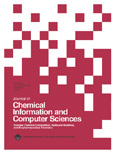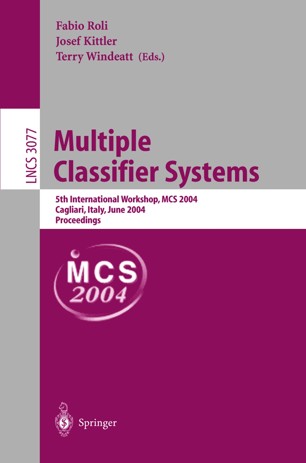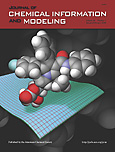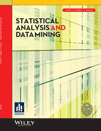Christopher Tong
List of Selected Publications and Abstracts
Project maintained by hydrodynamicstability Hosted on GitHub Pages — Theme by mattgraham
Empirical Modeling of Quantitative Structure-Activity Relationships (QSAR)
Machine learning methods used: random forest; stochastic gradient boosting; association rule learning.




Journal Publications (Refereed)
-
J. Ma, C. Tong, A. Liaw, R. Sheridan, J. Szumiloski, and V. Svetnik, 2009: Generating hypotheses about molecular structure-activity relationships (SARs) by solving an optimization problem. Statistical Analysis and Data Mining, 2: 161-174.

- Published in the Special Issue on Chemogenomics, Part II.
-
V. Svetnik, T. Wang, C. Tong, A. Liaw, R. P. Sheridan, and Q. Song, 2005: Boosting: an ensemble learning tool for compound classification and QSAR modeling. Journal of Chemical Information and Modeling, 45: 786-799.

-
V. Svetnik, A. Liaw, C. Tong, J. C. Culberson, R. P. Sheridan, and B. P. Feuston, 2003: Random forest: a classification and regression tool for compound classification and QSAR modeling. Journal of Chemical Information and Computer Sciences, 43: 1947-1958.

- This is by far the most frequently cited journal paper I have co-authored; Google Scholar shows over 4000 citations. According to Prof. Peter Willett, as of May 2020, this is the fourth most cited paper in the entire field of cheminformatics published between 1978-2018. The Altmetrics page for this paper shows that blogger Stephen Turner called this paper “the best explanation of Random Forest I’ve come across” (Getting Genetics Done, 2/24/2011); Nathan Brown called it “seminal” (6/15/2018).
Conference Papers (Refereed)
-
V. Svetnik, A. Liaw, C. Tong, and T. Wang, 2004: Application of Breiman’s random forest to modeling structure-activity relationships of pharmaceutical molecules. Multiple Classifier Systems, Fifth International Workshop, MCS 2004, Proceedings, 9-11 June 2004, Cagliari, Italy; F. Roli, J. Kittler, and T. Windeatt (eds.). Lecture Notes in Computer Science, vol. 3077. Berlin: Springer, 334-343.

- This is by far the most frequently cited conference paper I have co-authored.
Conference Papers (Unrefereed)
-
V. Svetnik, A. Liaw, and C. Tong, 2004: Variable selection in random forest with application to quantitative structure-activity relationship. IIASS International School on Neural Networks “E. R. Caianiello” 7th Course: Ensemble Methods for Learning Machines, 22-28 September 2002, Vietri sul Mare, Salerno, Italy. (I am not certain of the accuracy of this citation.)
- IIASS = International Institute for Advanced Scientific Studies.
-
C. Tong, V. Svetnik, and A. Liaw, 2003: Quantitative structure-activity-relationship modeling using Leo Breiman’s random forest. Joint Statistical Meetings 2003, 3-7 August 2003, San Francisco, California. American Statistical Association 2003 Proceedings, Section on Physical and Engineering Sciences, 4263-4266.
- Runner-up for the JSM 2003 Oustanding Presentation Award, from the ASA Section on Physical and Engineering Sciences.
Conference Abstracts
-
M. Torrent, C. Tong, A. Liaw, R. Nachbar, Y. Gao, R. Mosley, and C. Culberson, 2007: Molecular modeling-assisted attenuation of undesirable PXR activity. In Silico ADMET Conference: The Role of Protein-Structure Information in ADMET Prediction, 16-17 May 2007, London, U.K.
-
A. Liaw, C.Tong, T.-C. Wang, and V. Svetnik, 2006: How to find drugs with trees: applications of ensemble methods in QSAR modeling. 2006 ENAR Spring Meeting, 26-29 March 2006, Tampa, FL.
- ENAR = Eastern North American Region of the International Biometric Society.
-
S. Ha, C. Tong, R. Perlow-Poehnelt, J. H. Lin, J. C. Culberson, R. P. Sheridan, and J. Hochman, 2005: QSAR models for predicting p-glycoprotein activity of antagonists for a GPCR target. 230th American Chemical Society National Meeting and Exposition, 28 August - 1 September 2005, Washington, D.C., MEDI 146A.22.
-
V. Svetnik, T. Wang, C. Tong, and A. Liaw, 2005: Application of ensemble learning for modeling of quantitative structure-activity relations of pharmaceutical molecules. Joint Annual Meeting of the Interface Foundation of North America and the Classification Society of North America, 8-12 June 2005, Saint Louis, Missouri.
-
C. Tong, V. Svetnik, A. Liaw, R. P. Sheridan, J. C. Culberson, B. P. Feuston, R. Evers, and D. Hartley, 2003: QSAR prediction of ADME parameters using a new machine learning tool–random forest. Predictive ADME, 17-18 November 2003, Boston, Massachusetts.
- Media coverage: “Christopher Tong…discussed the application of the machine learning tool Random Forest for QSAR prediction of ADME parameters. This approach was found to be an accurate means of predicting blood-brain barrier permeability and P-gp transport of test compounds, while resisting overfitting and being robust to parameter tuning and noise.” – C. Watson, Drug Discovery Today: Biosilico, 2 (2): 55-56 (March 2004).
Notes
ADME = Absorption, Distribution, Metabolism, and Excretion.
ADMET = same, except add Toxicity.
(c) 2022-2025 by Christopher Tong